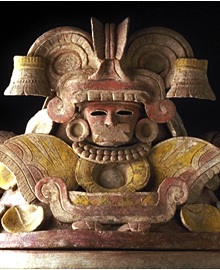resources
Teacher's Resources - A Question of Ritual

For the people of the ancient Americas as for many other humans worldwide, ceremonies formed a bridge between their world and that of deities and spirits. Through sacred rituals they communicated to their gods and ancestors their hopes for a bounty of food, protection from the potential disasters wrought by nature or political enemies and general good fortune, thus forming a bridge between the living and the metaphysical.
In the Mesoamerican and Andean belief systems, many different rituals involving dances, ceremonies, festivals and games were performed to maintain a sense of order and balance and to create the conditions necessary for prosperous human cultures to unfold. Much has been made of the evidence for the practice of human sacrifice in both regions; certainly it appears to have been practiced, as it was in certain civilizations all over the world, including Imperial Rome, the early Celtic settlements of Western Europe, and many others.
What is more interesting and fruitful to pursue with students is an exploration of the possible belief systems that gave meaning to the CLOTH & CLAY objects, such as this ritual incense burner from Teotihuacan, an ancient Mexican culture.
Classroom Activities and Projects (recommended ages are in italics and are approximate)
1. 12 -16: In groups or as individuals, students can research the symbolism of the mountain in ancient American cultures, investigating such areas as sacred geometry, layout of cities and ritual sites, pyramids, and rituals. The results of the research can result in essays, as well as drawings and 3-dimensional models.
2. 12 -16: Within a larger project comparing the beliefs of ancient peoples around the world, students can investigate those of the ancient Americas, including shamanism, use of psychotropic plants, and human sacrifice, tying these practices to the religious beliefs of the cultures practicing them. Class discussions can touch on how easy it is to sensationalize these practices, and the importance of putting them in context with the larger belief systems of the civilizations under review.
3. 12 - 16: Research on the Day of the Dead, a yearly festival in Mexico that takes place in early November, provides insight into ancient and contemporary religious beliefs and rituals. By studying this and other festivals, students who are growing up in the secular societies of the West can develop an understanding of life in a deeply religious culture. Similarly, students who are themselves rooted in a religious culture can learn about other belief systems.
In its original form, this festival took place during Miccailhuitontli (late summer) in the Aztec calendar, and celebrated the life cycle, honouring the newly dead and the ancestors. Today the day corresponds to All Saints Day in the Christian calendar.
Students working in groups can present the results of their research to the class, with each group covering different aspects of the festival such as the variety of forms taken by the festivities, the combined Christian/pre-Christian elements, and the significance of ofrendas, calaveras and other related objects.